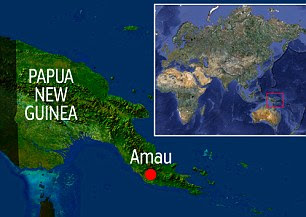 Miniscule: This tiny frog, believed to be the smallest vertebrate on Earth, has been discovered by scientists in Papua New Guinea
Miniscule: This tiny frog, believed to be the smallest vertebrate on Earth, has been discovered by scientists in Papua New GuineaPerched on a coin the size of a 5p piece, there is still probably room for two.
At half the size of a Smartie sweet, this is the world’s smallest frog, measuring just a quarter of an inch long.
Scientists discovered the previously unknown creature, speckled in red and black, sitting on a leaf on the tropical island of Papua New Guinea.
At just 7.7mm in size when fully grown, it has snatched the title as the smallest of the world’s 60,000 vertebrates – creatures with a backbone – previously held by a tiny Indonesian fish which measures 7.9mm.
 The tiny creature was discovered in Amau, Papua New Guinea
The tiny creature was discovered in Amau, Papua New GuineaExperts are baffled by the find as it was previously thought extreme body size in vertebrates, whether large or small, was associated with living in water.
Professor Chris Austin, of Louisiana State University, who discovered the frog on a three-month field trip to the Pacific island, said by contrast these creatures make their habitats on fallen leaves on the floor of tropical rainforests.
 His discovery of the creatures, named Paedophryne amanuensis after a village called Amau near where they were found, will help scientists understand more about extreme body size, he wrote in the journal PLoS One. They are thought to have evolved ‘extreme miniaturisation’ to fill a hole in the food chain which was not being exploited by others, perhaps to eat minuscule creatures such as mites which would not sustain larger frogs.
His discovery of the creatures, named Paedophryne amanuensis after a village called Amau near where they were found, will help scientists understand more about extreme body size, he wrote in the journal PLoS One. They are thought to have evolved ‘extreme miniaturisation’ to fill a hole in the food chain which was not being exploited by others, perhaps to eat minuscule creatures such as mites which would not sustain larger frogs.It was no easy job to find one, but his team followed the high-pitched calls made by adult males when they are looking for a mate.
The tiny specimen fits comfortably on a US dime, which measures 17.9mm, slightly smaller the size of a 5p piece which measures 18mm.
Prof Austin said: ‘We now believe they aren’t just biological oddities, but instead represent a previously undocumented ecological guild - they occupy a habitat niche that no other vertebrate does. ‘It was particularly difficult to locate Paedophryne amauensis due to its diminutive size and the males’ high pitched insect-like mating call. ‘But it’s a great find.
New Guinea is a hotspot of biodiversity, and everything new we discover there adds another layer to our overall understanding of how biodiversity is generated and maintained.’
source: dailymail













